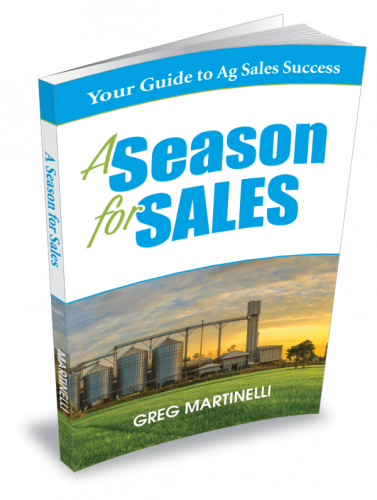How to navigate the deep waters of selling in agribusiness
Today, as you jump into your pickup and venture out into your sales territory, remember that there can be some treacherous waters out there. These waters are filled with dangerous reefs, strong currents, and menacing creatures. But they are also filled with opportunities, new worlds, and a lifetime of great experiences.
Hold on to the ship’s wheel as we take a few minutes to navigate through the 7 seas of selling in agribusiness
1. A Sea of Objections
Let’s navigate these waters right away. You are going to run smack into a wall of objections and negativity. These waters have dashed more sales careers on the rocks than maybe any other.
The struggle is that we get hired. Then we get pumped up with a lot of internal positivity from our company (which is fine). However, we go out into our market and run into customers who don’t trust our information, who have their own information or just don’t want our information. They have heard it all before and will use any objection necessary to get you off their farm.
Smooth Saling Tips:
- Get better questions
- Listen better to your customer’s answers.
- Learn how to question their answers (this is one step beyond just asking good questions).
- Solve their problems in their words according to their value
2. A Sea of Sameness
Often you are stuck in the sea of objections because you simply look and sound like everyone else.
During sales training workshops, I like to illustrate this with an example of a grain farmer in the corn belt. I work with a lot of agronomy sales teams, who sell seed. They have a lot of competition. They can easily drown in a sea of sameness.
I ask them, “How many viable competitors do you have in your territory? By viable, I mean can actually provide effective products and services?”
They typically start to count until they reach close to 20.
Then I ask them to think about the average grain farmer. If a salesperson calls on a prospect one to two times a month, that means that farmer is being called on 20-30 times a month! That sounds high, but it is happening. Our farmer customers get really good at getting rid of salespeople.
Next, I ask, “How many of your competitors have a book of plots and graphs that depict their line of seed is the best?”
All of them raise their hands.
Again, I ask them to think about their farmer customer. With an onslaught of plot data and graphs, they all become forgettable or worse, contradictory. So, they keep you in the Sea of Sameness.
Smooth Saling Tips:
- Differentiate, differentiate, differentiate
- Read last week’s blog: The Gold in Your Gift
- Get good at answering two primary selling questions
3. A Sea of Mediocrity
This is a tough sea to escape. It’s like a slow boil until you realize you have been coasting along, having some success, and living off the rewards of that success. Your tailwind is gone and you have to start paddling just to keep from sinking.
You start out in sales, have some success, and just keep repeating that pattern. There is nothing wrong with that until it no longer works. Maybe you had a product advantage or a technology advantage. You were the only one in the market with it. Sales were good and margins were even better. What could possibly go wrong? Why change anything?
Competition! That’s what goes wrong and why you need to change. High margins and high sales volumes will draw attention. It doesn’t take long for competitors to lose some sales before they copy or counter your go-to-market strategy.
Smooth Saling Tips:
- Differentiate, differentiate, differentiate…. applies here as well
- Adopt a mindset of continuous improvement. Study the principles of Six Sigma, change management, etc.
- Realize that products, services and even you go through the product stages of start-up, growth, cash cow, and decay. You want to respond to all stages by:
- Always be on the lookout for another start-up product or service
- Feed the growth part of your sales
- Harvest from the cash cow products and services.
- Cull those parts of your territory that are in decay. They are slowing you down.
4. A Sea of Information
This sea sounds great until you realize it’s a giant labyrinth that is easy to get lost in. You will sail your ship in circles for hours a day before realizing you got nowhere.
Data and technology are rampant in agribusiness. There has been an explosion of venture capital investments in Ag technology over the last ten years. The result has been software and hardware flowing into the market. All with great intentions.
I am a big proponent of data, technology, and improving our selling skills with it. However, with limited time and resources, the Ag salesperson has to be efficient. Drones are a good example of this. They are a great tool. But how will they be implemented? Farmer flown, private company flown, or combined with satellite imagery? Who will interpret the data gathered by the drones? It’s not a tool to be dismissed as we have a labor shortage and it helps in this area, not to mention quicker and more coverage than a scout.
Drones are just one aspect in the sea of Information-Technology for salespeople. There are many others: CRM, BI tools,
Smooth Saling Tips:
- Categorize: With too much for us to synthesize in our daily thoughts, categorize the data and technology to make sense of it.
- Prioritize: After categorizing, sort by priority: short-term (6 mo-1 year), long-term (1-2 years). Or really long-term (maybe never but remaining aware of it).
- Dip your toe in the water by incorporating new information and technology on a continuous basis. However, always proof it in multiple ways. A single source of information can easily be biased or just wrong. Bounce your new found information off others in the industry. Determine what the governing trade association thinks about it. Go to the center of excellence for your industry to see what they think of it.
5. A Sea of Opportunity
The great thing about agribusiness is that it’s never going away. Nobody quits eating. As a matter of fact, there continues to be a population increase, a farming land decrease, and a growing middle class who desire to eat better.
To me, that means there are a lot of challenges (opportunities). Products, services, and technology will come and go, but the Ag industry will be here for a long time.
So, no matter how difficult it gets for you, keep navigating opportunities. Remain positive in the contribution this industry makes to safe, affordable food for more and more people, on fewer and fewer acres, under more and more restrictions.
6. A Sea of Change
I have only been at it for 30 years, but there has been a constant change since the day I started.
We were pushing P&Ls down to the lowest business unit. Then we consolidated it all into regional or national P&Ls.
We were owning delivery trucks and managed the distribution system. Then we outsourced it all. The ethanol boom shifted the grain landscape. Then came the farmland boom in the last 10 years combined with high commodity prices before inputs caught up.
There has been a trade war or skirmish in almost every one of my 30 years.
Smooth Saling Tip:
- Ride the waves versus holding the wall of water back: As an industry professional, you have to balance between a passing fad versus a new trend. All I know is adopting only one strategy will typically lead to your downfall.
For example, if you resist all change, it’s inevitable this will lead to lost opportunity or worse for you. Look at any of the changes in Ag over the last 30 years. Could your business have survived all of those events without changing? If so, great. But I am guessing somewhere in those events, your business adapted to survive and thrive.
The other extreme can be just as deadly. Jumping from one fad to the next or even one trend to the next can have damaging effects on continuity. We get sensitized to so much change and we wait out anything new. We find it hard to commit to anything new as it might change by tomorrow. I see this effect with a lot of start-up businesses I work with. They pivot so fast from products, structure, or other go-to-market strategies that the sales team loses confidence in their efforts.
7. A Sea of Uncertainty
If you sailed through the previous six seas, you will arrive at a point where you realize, there is a lot of uncertainty in our industry.
To deal with that uncertainty, you can employ some of these tactics:
Smooth Saling Tips:
- Confidence: There is a saying that the only things certain in life are death and taxes. I would add hunger to that list. Feel confident in that one little piece of certainty that you are in a high-demand industry.
- Get comfortable being uncomfortable. Change is going to happen. If you work hard and try, then you can be part of the new era. You can make it through the stormy sea of uncertainty into the tranquil waters of the new way of going to market.
- When fear crops up (like every day), acknowledge it for what it is… an emotion. It’s there for a reason. Sometimes, it keeps you from harm, while other times, it’s just needless worry. Seek out some fear management techniques. Here is an article and podcast on handling five of the more common sales fears: Selling through Fear.
I hope these tips helped you as you set sail through the stormy but rewarding seas of selling in agribusiness!


